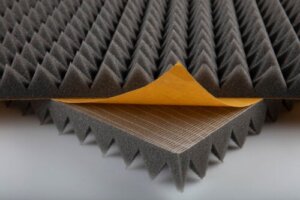Acoustic Panels: Decoration and Functionality

Some particular areas in buildings have special sound requirements. Rehearsal rooms, meditation offices, or recording studios use sound insulation technologies so that noise doesn’t echo. However, it’s also possible to install acoustic panels in everyday environments.
This type of covering works to achieve less noise pollution. In addition, they’re designed to be decorative, but not to interfere, and they can even improve a room’s design.
Work offices, study offices and all activities that require concentration can be improved through acoustic panels. We’ll tell you how.
What are acoustic panels used for?
They’re panels with different shapes and colors that work to absorb sound. That’s to say, they reduce the echo and reverberation that sounds produce in an environment. Through the material that most of them are made with, which is PET felt, it’s possible to improve acoustics.
Especially where concentration is required, such as in study rooms or work offices. Sound-absorbing capacity is achieved through porous and soft materials, such as the composition of cushions and mattresses. However, acoustic panels are objects adapted to the room’s walls and ceilings.
The purpose is not to interfere with a room’s decoration, while reducing noise. They usually have sizes ranging from half a meter to a meter (1.7 to 3.3 feet), with a thickness of 3 or 4 centimeters (1.2 to 1.6 inches).
They’re very easy to hang and install. In this way, areas with good acoustics can be achieved through easy-to-apply accessories, without the need for complex repair work, and giving the area a decorative character.

Read more: Are You Absent-Minded or Forgetful? Here Are 10 Tips to Help
Advantages of acoustic panels
In addition to reducing echo and noise pollution, acoustic panels have a number of advantages that make them ideal for any room. The variety of designs and adaptability allows them to be easily installed in any environment.
- Absorption. They’re functional and prevent the generation of mold, since they absorb and then release the moisture.
- Customization. Acoustic panels offer different shapes, textures, and colors, so it’s possible to adapt them to the decoration.
- Durability. The material they are made with prevents them from deteriorating. They don’t lose color and won’t deform over time.
- Environmentally friendly. They don’t release emissions of any kind, and help to maintain a healthy environment.
- Ease of installation. The installation of acoustic panels is very simple and doesn’t require complex work on the wall or ceiling.
- Acoustic conditioning. They differ from sound-absorbing acoustic insulation, a typical tool used in rehearsal rooms. Conditioning improves the sound inside an area.
Types of acoustic panels according to where you install them
There’s a wide variety of panels, depending on the desired decorative format. However, the main difference between them is where you install them. Some are designed to cover walls, while others are designed for ceilings.
Wall panels
Decorating a wall with acoustic panels helps to reduce noise and, in addition, to include your own design in the room. These panels adhere easily and offer models with triangular, smooth, or hexagonal shapes. There are also vertical types, which provide uniformity and visual appeal.
Another common option is circular panels, which cover a wall space and create a sense of elegance. On the other hand, it is possible to select between different colors for any model, and even combine more than one.

Ceiling panels
Another type of acoustic panel is the one you install on the ceiling. In this case, it’s an article made of light and resistant materials, prepared to absorb humidity. They can be installed by means of screws, nails, or even by hanging them, which produces a greater decorative effect.
The materials can be acoustic foam, rock wool, or fiberglass. In addition to this, thay can be made with PET felt, made from recycled elements, and with textile finishes for decoration.
This type of panel is ideal for large rooms with little furniture. In these spaces, sound bounce is usually greater and interferes with conversations.
Read more: Eco-Friendly Decoration: Sustainable Ways To Decorate Your Home
Maintenance of acoustic panels
The main maintenance task that should be performed on these elements is cleaning and dust elimination. Avoid getting too much dirt on them by using cloths and rubbing gently.
It’s also possible to apply soap and a little water, always in a delicate way. This cleaning method is mainly for ceiling panels.
All cited sources were thoroughly reviewed by our team to ensure their quality, reliability, currency, and validity. The bibliography of this article was considered reliable and of academic or scientific accuracy.
- Pinargote Cantos, Mayra Elizabeth, Suanny Daniela Ramírez Rodríguez, and Victoria Kety Obando Ponce. “Propiedades Acústicas Del Aserrín y Fibra de Coco En Un Panel Acústico Para El Interior de Las Edificaciones.” Sinergia Académica 4.2 (2021). Disponible en: https://doi.org/10.51736/sa.v4i2.55
- MEZA MARÍN, LEONARDO G. , RECUERO LÓPEZ, MANUEL , Análisis y Comparación de Aislamiento Acústico en Viviendas y Edificios de Nueva Construcción. Revista de la Construcción [Internet]. 2008;7(1):20-26. Recuperado de: https://www.redalyc.org/articulo.oa?id=127612580002
- Carbajo, Jesús et al. “Una Alternativa Para El Estudio Acústico de Paneles Perforados.” VIII Congreso Ibero-Americano de Acústica. N.p., 2012. 1–11. Disponible en: http://ftp.sea-acustica.es/fileadmin/publicaciones/101.pdf
- Rodríguez, Antonio, Medina, Eduardo, Díaz, Cesar, Caballol, David, Aislamiento acústico entre recintos superpuestos de gran volumen con forjados autárquicos. Revista de la Construcción [Internet]. 2013;12(3):47-52. Recuperado de: https://www.redalyc.org/articulo.oa?id=127631072005
This text is provided for informational purposes only and does not replace consultation with a professional. If in doubt, consult your specialist.








